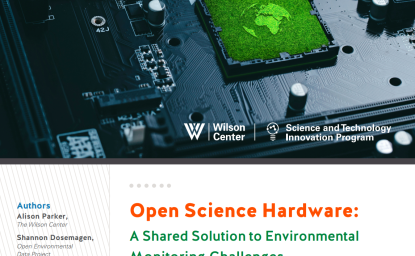
A blog of the Science and Technology Innovation Program
This article was written as part of the Future of Open Science Policy project, a partnership between the Federation of American Scientists, the Center for Open Science, and the Wilson Center. This project aims to crowdsource innovative policy proposals that chart a course for the next decade of federal open science. To read the other articles in the series, and to submit a policy idea of your own, please visit the project page.
During the Year of Open Science, the White House Office of Science and Technology Policy and federal science agencies are building opportunities for enhancing public access to science. Indeed, following the White House's directive to federal agencies to provide free access to taxpayer-funded research results, agencies like NIST and NIH shared their preliminary plans. The scientific community is engaging with these plans, signaling a positive movement towards a more transparent research ecosystem. However, the core question emerges: how can the federal government support opening the process of science, in addition to scientific products? Here, we highlight the transformative potential of open source for science and describe the need for institutional support.
The Transformative Potential of Open Science
The transformative potential of open science extends beyond accessibility; it holds the promise of fundamentally reshaping the process of science. The evolution of scientific tools, both digital and physical, along with modern scientific infrastructure, underscores this shift. Scientific advancements stem not just from publications, but also from data sets, algorithms, scripts, protocols, workflows, design files, and documentation. The pace of progress accelerates when these tools are developed and used collectively.
The Office of Science and Technology Policy and the National Science and Technology Council define open science as a commitment to making research outcomes and methods accessible to everyone, ensuring respect for diverse cultures, safeguarding security and privacy, and enhancing collaboration, reproducibility, and equity. It prioritizes not just increasing the reach and impact of scientific publications but also fostering an environment of shared growth by making the scientific process more transparent. To that end, open science is not just about granting access to papers and data, but about redefining the conduct of science.
Software and hardware are essential tools for science. Researchers in academia are part of global communities of scientists and contributors intentionally developing software and hardware for scientific purposes. As a recent article from the Research Software Alliance describes, open source software refers to code, algorithms, scripts, computational processes, and executable programs designed for collaborative usage. Similarly, according to the Open Source Hardware Association, open source hardware pertains to designs that are publicly available, allowing for studying, modification, production, and commercialization based on those designs. In some disciplines, open source software is now the backbone of advancement, and in others, open source practices in both software and hardware are becoming more familiar, as described by landscape analyses of the field (c.f. PLOS Computational Biology; Open Science Hardware Policy).
Both open source software and hardware are being used in a variety of high-impact projects. Some examples demonstrate the breadth, creativity, and impact of current open science initiatives:
- The OpenFlexure project develops open-source, customizable laboratory-grade optical microscopes, designed to be assembled by individuals using 3D printed components and simple, widely available hardware, maximizing accessibility and adaptability.
- Jupyter Notebooks allows researchers to embed live code, visualizations, and narrative text in documents, making experiments transparent, fostering reproducibility with shareable data and analysis steps, and facilitating collaborations through its web-based interface accessible to diverse communities worldwide.
- ImageJ is a widely used open source imaging platform with an open architecture that supports extensibility through Java plugins, encourages community collaboration, and offers transparent access to its source code, all while providing robust image processing capabilities for diverse research purposes.
- A recent NSF funded project is developing cloud-based tools for the curation and analysis of geomaterial image data and deploys these tools on the Digital Rocks Portal (DRP) to ensure that the data and tools generated and refined from this project are openly accessible, adaptable, and come with training resources.
These projects, and many others, showcase the ways in which open science in software and hardware are pushing science forward through accessible and open tools.

Institutional Support Challenges
However, open source software and hardware for science lack institutional support. New kinds of scholarly activities that are essential to open source—such as software development, hardware design, and community management—are often pigeonholed into the infrastructure set up for other kinds of research products. The development of software and hardware tools for science requires unique experience and skills, but landscape analyses show that there are not yet recognized professional roles and incentive structures for career paths that are distinct from other parts of the research process. According to researchers in the field, Technology Transfer Offices in academic institutions and federal agencies could play an important role in increasing the impact of technologies developed with public funds, but most are solely focused on traditional models of intellectual property.
The lack of institutional support for open source is particularly apparent in the US federal government, which until this year has been particularly slow to champion a culture of research transparency and inclusivity through open science and open source. Part of this hesitation stems from inherent challenges that crisscross different sectors, agency missions, and authorities. Building a robust open source infrastructure requires recruiting and retaining skilled professionals. While training initiatives like the Carpentries are enhancing expertise both inside and outside the government, federal agencies grapple with a traditional mode of operation that leans heavily on contracting external entities to develop proprietary systems for government programs. Governments at all levels also lack precedent and incentives for procuring open source software and hardware, even when these tools and instruments are demonstrably more cost-effective over the long term.
However, solutions to these challenges are emerging, primarily from academia and the private sector. One path forward is the Open Source Program Office (OSPO) which serves as an organizational hub for open source activities, covering training, legal compliance, community engagement, and policy formulation. The adoption of OSPOs by global institutions such as the European Commission and the World Health Organization is a testament to its effectiveness. Moreover, the Center for Medicare and Medicaid has set a precedent by being the first federal agency to establish an OSPO.
Towards a Vibrant Open Source Environment in Government
Addressing these intricate challenges and developing these solutions demands a plethora of innovative ideas. The federal government's role in nurturing a vibrant, inclusive, and user-friendly open source environment is paramount. It's essential to tap into the experiences of scientists to understand the actual mechanics of open science and identify where we're losing out on shared growth opportunities. The unique value of open source to science must be acknowledged and prioritized along with other kinds of research outputs.
To address these challenges, the Federation of American Scientists, the Center for Open Science, and the Science and Technology Innovation Program at the Wilson Center launched the Open Science Policy Sprint. This initiative seeks your most constructive suggestions on how the government can build institutional capacity for open science. We’re looking for a range of ideas that support more open science, defined broadly; from open data and open access, to participatory science, to ways of building a more inclusive and equitable science ecosystem. To participate, add a short description of your idea, the motivation behind it, the policy customer, a plan of action, and an outcome using the submission form. For selected ideas, authors will be invited to work with our team to strengthen policy recommendations and get them in front of policy leaders in the White House, Congress, and federal agencies. We invite your insights!
Authors



Science and Technology Innovation Program
The Science and Technology Innovation Program (STIP) serves as the bridge between technologists, policymakers, industry, and global stakeholders. Read more





